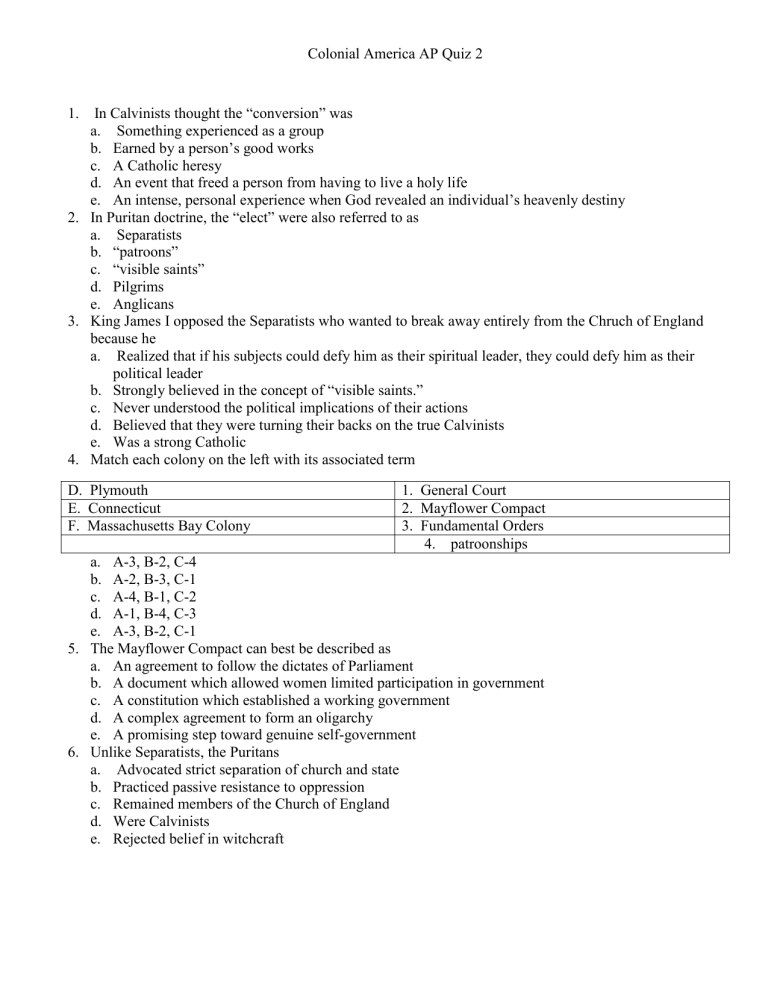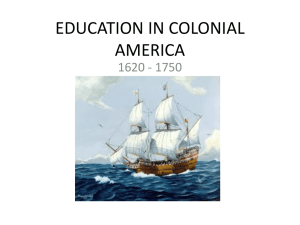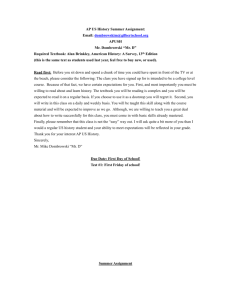Colonial America Quiz 2 Multiple Choice Questions

Colonial America AP Quiz 2
1.
In Calvinists thought the “conversion” was a.
Something experienced as a group b.
Earned by a person’s good works c.
A Catholic heresy d.
An event that freed a person from having to live a holy life e.
An intense, personal experience when God revealed an individual’s heavenly destiny
2.
In Puritan doctrine, the “elect” were also referred to as a.
Separatists b.
“patroons” c.
“visible saints” d.
Pilgrims e.
Anglicans
3.
King James I opposed the Separatists who wanted to break away entirely from the Chruch of England because he a.
Realized that if his subjects could defy him as their spiritual leader, they could defy him as their political leader b.
Strongly believed in the concept of “visible saints.” c.
Never understood the political implications of their actions d.
Believed that they were turning their backs on the true Calvinists e.
Was a strong Catholic
4.
Match each colony on the left with its associated term
D. Plymouth
E. Connecticut
1. General Court
2. Mayflower Compact
F. Massachusetts Bay Colony 3. Fundamental Orders
4.
patroonships a.
A-3, B-2, C-4 b.
A-2, B-3, C-1 c.
A-4, B-1, C-2 d.
A-1, B-4, C-3 e.
A-3, B-2, C-1
5.
The Mayflower Compact can best be described as a.
An agreement to follow the dictates of Parliament b.
A document which allowed women limited participation in government c.
A constitution which established a working government d.
A complex agreement to form an oligarchy e.
A promising step toward genuine self-government
6.
Unlike Separatists, the Puritans a.
Advocated strict separation of church and state b.
Practiced passive resistance to oppression c.
Remained members of the Church of England d.
Were Calvinists e.
Rejected belief in witchcraft
7.
With the franchise in Massachusetts extended to all adult males who belonged to Puritan congregations, the proportion of qualified voters (approximately 2/5) in this colony as compared to England was a.
Larger b.
Somewhat smaller c.
About the same d.
Not known e.
A great deal smaller
8.
Puritan religious beliefs allowed all of the following except a.
Drinking alcohol b.
Eating plentifully c.
Challenging religious authority d.
Making love discreetly e.
Singing songs
9.
Among the Puritans, it was understood that a.
They would establish democratic government in America b.
Clergymen would hold the most powerful political office c.
The purpose of government was to enforce God’s laws d.
All adult white male landowners could vote for political leaders e.
Women could become religious leaders
10.
Roger Williams’ beliefs included all of the following except a.
Breaking away from the Church of England b.
Demanding oaths regarding religious beliefs c.
Condemning the taking of Indian land without fair compensation d.
Denying the authority of the civil government to regulate religious matters e.
Challenging the legality of Massachusetts Bay’s charter
11.
After the Pequot War, Puritan efforts to convert Indians to Christianity can best be described as a.
Vigorous but unsuccessful b.
More zealous than those made by Catholics, but still unsuccessful c.
Filling “praying towns” with hundreds of Indians d.
Feeble, not equaling that of the Spanish or French e.
Very successful
12.
King Philip’s War resulted in a.
The lasting defeat of New England’s Indians b.
France’s moving into Canada c.
The formation of a powerful alliance among the Indians to resist the English d.
The last victory for the Indians e.
None of the above
13.
During the early years of colonization in the New World, England a.
Closely controlled its colonies b.
Maintained an excellent relationship with the Indians c.
Paid little attention to its colonies d.
Made sure all the colonies had royal charters e.
Began the importation of African slaves
14.
The Dominion of New England a.
Included all the New England colonies b.
Was created by the English government to streamline the administration of the colonies c.
Was designed to bolster colonial defense d.
Eventually included New York and east and west New Jersey e.
All of the above
15.
As a result of England’s Glorious Revolution, a.
The Dominion of New England collapsed b.
Sir Edmund Andros gained control over Massachusetts c.
Massachusetts regained its original charter d.
Opposition to English rule in the colonies subsided e.
James II regained his legitimate right to the crown
16.
New York was a.
The best advertised of all the colonies b.
Designed as a Quaker refuge c.
Originally founded by the Dutch d.
A major contributor to political democracy and religious tolerance in the English colonies e.
The last of the middle colonies to be established
17.
One of the traits that made Quakers unpopular in England was a.
Their refusal to do military service b.
The high pay given their clergy c.
Their support of slavery d.
Their violent treatment of their enemies e.
Their refusal to hold public office
18.
Indian policy in early Pennsylvania can be best described as a.
Extremely harsh b.
Bad at first but improving later c.
Influenced mainly by the state supported church d.
Benevolent e.
None of the above
19.
All of the middle colonies were a.
Founded by proprietors b.
Established by joint-stock companies c.
Notable for their fertile soil d.
Intended as religious havens e.
Dependent on slave labor
20.
The middle colonies were notable for their a.
Lack of good river transportation b.
Unusual degree of democratic control c.
Lack of industry d.
Status as the least “American: of the colonies e.
Established churches
21.
The population of the Chesapeake colonies throughout the first half of the 17 th
century was notable for its a.
Fast growth rate b.
Scarcity of women c.
Low death rate d.
Stable family life e.
Large percentage of middle aged men
22.
In the 17 th
century, due to a high death rate families were both few and fragile in a.
New England b.
The Chesapeake colonies c.
The middle colonies d.
Georgia e.
Florida
23.
The “headright” system, which made some people very wealthy, consisted of a.
Using Indians as forced labor b.
Giving land to indentured servants to get them to come to the New World c.
Giving the right to acquire fifty acres of land to the person paying the passage of a laborer to
America d.
Discouraging the importation of indentured servants to America e.
Giving a father’s wealth to the oldest son
24.
Over the course of the 17 th
century, most indentured servants a.
Became landowners b.
Devolved into slavery c.
Managed to escape the terms of their contracts d.
Faced increasingly harsh circumstances e.
Saw their wages increase
25.
Bacon’s rebellion was supported mainly by a.
Young men frustrated by their inability to acquire land b.
The planter class of Virginia c.
Those protesting the increased importation of African slaves d.
People from Jamestown only e.
The local Indians
26.
The majority of African slaves coming to the New World a.
Went to English North America b.
Were delivered to South America and the West Indies c.
Came to New England d.
Were brought by the Dutch e.
Died before reaching their destination
27.
As a result of Bacon’s rebellion, a.
African slavery was reduced b.
Planters began to look for less troublesome laborers c.
Governor Berkeley was dismissed from office d.
Nathaniel Bacon was named to head the Virginia militia e.
Better relations developed with local Indians
28.
The physical and social conditions of slavery were the harshest in a.
Maryland b.
Virginia c.
South Carolina d.
Massachusetts e.
Pennsylvania
29.
Compared with indentured servants, African American slaves were a.
Less reliable workers b.
More likely to rebel c.
Cheaper to buy and own d.
A more manageable labor force e.
Less expensive to buy but more expensive to keep
30.
Urban development in the colonial South a.
Rivaled that of New England b.
Kept pace with the growth of large plantations c.
Led to the construction of an excellent highway system d.
Was slow to emerge e.
Occurred without the development of a professional class
31.
It was typical of colonial New England adults to a.
Marry early and have several children b.
Be unable to read and write c.
Arrive in New England unmarried d.
Die before becoming grandparents e.
Live solitary lives
32.
The New England family can best be described as a.
Relatively small in size due to the frequency of deaths from childbirth b.
A very stable institution c.
A limiting factor in the growth of the region’s population d.
Not very close-knit e.
Similar to the family in the Chesapeake colonies
33.
Southern colonies generally allowed married women to retain separate title to their property because a.
Of religious beliefs b.
Of English tradition c.
Southern men typically died young d.
Southern families were stable e.
Of a smaller number of men than women
34.
Puritans refused to recognize a woman’s separate property rights because a.
Of the short life span of New England women b.
They worried that such rights would undercut the unity of married persons c.
New England families were so rare d.
There was so little land available e.
Of all of the above
35.
The Puritan system of congregational church government logically led to a.
An authoritarian political government b.
The early establishment of religious toleration c.
Democracy in political government d.
The end of town meetings e.
None of the above
36.
All of the following were consequences of the Half-Way Covenant except a.
It weakened the distinction between the “elect” and others b.
It maintained the original agreement of the covenant c.
It conferred partial membership rights in the once-exclusive congregations d.
It increased the numbers of church membership e.
Women became the majority in the Puritan congregations
37.
The Salem Witchcraft trials were a.
A result of Roger Williams’s activities b.
The result of unsettled social and religious conditions in rapidly evolving Massachusetts c.
Caused by ergot in the Puritans’ bread d.
Unique to the English colonies e.
Accusations made by the daughters of business owners
38.
During the Salem witchcraft trials, most of those accused as witches were a.
Property-owning women b.
From the ranks of poor families c.
Primarily un-Christian d.
Women in their late teen years e.
From subsistence farming families
39.
The New England economy depended heavily on a.
Slave labor b.
The production of many staple crops c.
Fishing, shipbuilding, and commerce d.
Tobacco e.
All of the above
40.
In contrast to the Chesapeake colonies, those in New England a.
Had a more diversified economy b.
Expanded westward in a less orderly fashion c.
Had a more ethnically mixed population d.
Were more oriented toward the individual than community interests e.
Followed the land use pattern established by local Indians
BONUS:
Compared with most 17 th
century Europeans, Americans lived in a.
Relative poverty b.
Larger cities c.
Affluence abundance d.
A more rigid class system e.
More primitive circumstances
Name: ______________________________________ Date: _______________ Score
Colonial America Quiz 2
Directions: Please PRINT in CAPTIAL letters the best possible response to the multiple choice questions in the spaces provided. (2 points each)
1 E 2 C 3 A 4 B 5 E 6 C 7 A 8 C 9 C 10 B
11 D 12 A 13 C 14 E 15 A 16 C 17 A 18 D 19 C 20 C
21 B 22 B 23 C 24 D 25 A 26 B 27 B 28 C 29 D 30 D
31 A 32 B 33 C 34 B 35 C 36 B 37 B 38 A 39 C 40 A







